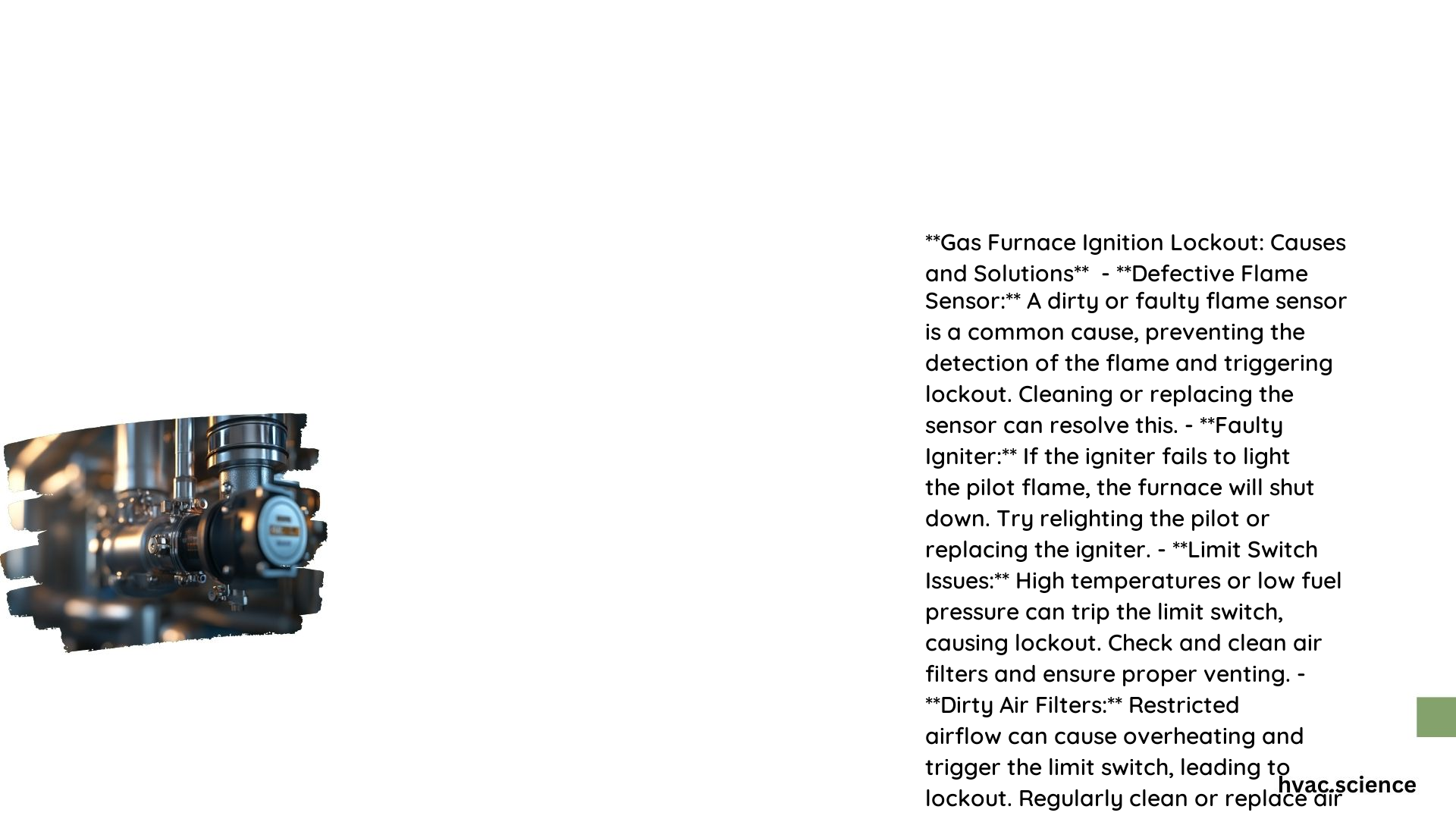Comprehensive Guide to Gas Furnace Ignition Lockout
A gas furnace ignition lockout is a safety feature that shuts down the furnace when it fails to ignite the burner after multiple attempts. This can happen due to various reasons, such as a faulty flame sensor, igniter, or issues with the gas supply. Understanding the causes and troubleshooting steps can help homeowners resolve the problem and restore their furnace’s proper operation.
What Causes Gas Furnace Ignition Lockout?
1. Defective Flame Sensor
- A faulty or dirty flame sensor is one of the most common causes of ignition lockout. The sensor fails to detect the flame, leading the controller to shut down the furnace.
- Symptoms: The furnace may attempt to ignite multiple times before entering lockout mode. Error codes related to flame failure (e.g., code 34) may be displayed.
2. Faulty Igniter
- If the igniter does not activate or fails to light the pilot flame, the flame sensor will not detect the flame, causing the furnace to shut down.
- Symptoms: The igniter may glow but fail to light the burner, resulting in repeated ignition attempts and eventual lockout.
3. Limit Switch Issues
- The limit switch monitors heat exchanger temperatures and fuel pressure. If the temperature is too high or the pressure too low, the limit switch will close, causing the furnace to enter lockout mode.
- Symptoms: A dirty air filter can reduce airflow, causing the limit switch to trip and leading to lockout.
4. Gas Supply Issues
- Issues with the gas supply, such as a clogged condensate drain or problems with the gas valve, can also cause ignition lockout.
- Symptoms: Error codes indicating ignition failure or retries may be displayed.
How to Troubleshoot Gas Furnace Ignition Lockout?
1. Identify the Issue
- Check the error codes displayed on the furnace. Common codes include:
- Code 34: Ignition proving failure.
- Code 14: Ignition lockout.
- Review the furnace manual to understand the specific error codes and their meanings.
2. Inspect and Clean the Flame Sensor
- Locate the flame sensor and clean it using a scouring pad. Ensure it is properly seated in the flame path.
- Tools Needed: Scouring pad, screwdriver.
- Safety Precautions: Ensure the power is off before cleaning the sensor.
3. Check the Igniter
- Verify the igniter is functioning correctly. If it is not lighting the pilot flame, it may need to be replaced.
- Tools Needed: Multimeter to check for proper voltage.
- Safety Precautions: Ensure the power is off before inspecting the igniter.
4. Inspect Air Filters and Vents
- Check and replace the air filter if it is dirty. Clean the vent pipes to ensure proper airflow.
- Tools Needed: Vacuum cleaner, replacement air filter.
- Safety Precautions: Ensure the power is off before cleaning the vents.
5. Check for Gas Supply Issues
- Inspect the condensate drain for blockages and ensure the gas valve is functioning correctly.
- Tools Needed: Multimeter to check for proper voltage, drain cleaning tools.
- Safety Precautions: Ensure the power and gas supply are off before inspecting the gas valve.
6. Measure Flame Signal
- Use a multimeter to measure the DC microamps flowing through the flame sensor while the burner is lit. Most systems require around 5 microamps to keep the gas valve open.
- Tools Needed: Multimeter.
- Safety Precautions: Ensure proper grounding and safety when measuring electrical signals.
What is the Difference Between Hard and Soft Lockout?
Soft Lockout
- A soft lockout occurs when the furnace attempts to ignite multiple times but fails. The furnace can usually be restarted after a short period, typically after two or three attempts.
- Example: If the flame sensor is dirty, the furnace may attempt to ignite a few times before entering a soft lockout. Cleaning the sensor and restarting the furnace may resolve the issue.
Hard Lockout
- A hard lockout occurs when the furnace fails to ignite after multiple attempts and will not restart until manually reset. This is often due to more serious issues such as a faulty igniter or limit switch problems.
- Example: If the igniter is faulty and fails to light the pilot flame after multiple attempts, the furnace will enter a hard lockout and require manual reset or professional repair.
Implications for Troubleshooting and Repair
- Soft Lockout: Typically easier to troubleshoot and fix, often requiring simple cleaning or replacement of components like the flame sensor.
- Hard Lockout: May require more extensive troubleshooting and potentially professional repair, as it indicates a more serious issue with the furnace’s safety sensors or critical components.
Reference Links
- Wolcott Services: How Do You Fix A Furnace Ignition Lockout?
- DoItYourself.com: Intermittant code #34 and then #14(ignition lockout)
- AVS Heating and Air Conditioning: How Do You Fix A Furnace Ignition Lockout?

